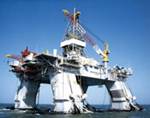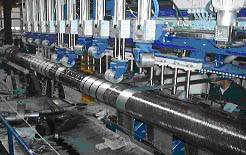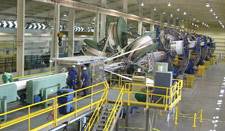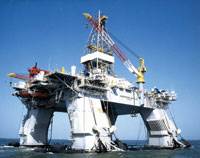Composites Key To Deepwater Oil and Gas
With crude prices at historic highs, oil and gas companies now have the incentive to actively engage in exploration and production (E&P) in many offshore areas worldwide.
With crude prices at historic highs, oil and gas companies now have the incentive to actively engage in exploration and production (E&P) in many offshore areas worldwide. Most large oil and gas fields have been found at depths greater than 914m/3,000 ft. Currently, drilling activities in the Gulf of Mexico have exceeded water depths of 2,440m/8,000 ft, and production facilities are being designed for construction beyond 1,220m/4,000-ft depths.
Deepwater E&P technology has become increasingly critical for effective, economical development of offshore fields. At present, offshore E&P facilities, including both topside platform structures and underwater subsea systems, have been designed and constructed with conventional materials, i.e., steel and concrete. In deeper fields, conventional materials become less practical, because of weight and fabrication considerations. Alternatives, such as advanced composites, offer significant enabling capabilities and economies that could facilitate and accelerate deepwater technology development for future offshore petroleum drilling and production. However, it also is clear that — owing to complex material, design and regulatory issues unique to offshore systems — significant development work must be done before the full potential of offshore composites can be realized.
Composite materials already are used in a number of secondary structures (not primary load-bearing components), including fire water main and deluge pipe, high- and low-pressure tubing, processing vessels and tanks, fire blast panels, accommodation modules, gratings and handrail. Composite structures have been developed and constructed for subsea processing (e.g., separators) and for protecting wellheads and satellites, manifolds, templates and pipelines. There also have been advances in fiber composites and syntactic foams for fire protection, thermal insulation and deepwater buoyancy. And newer developments, such as steel-strip laminate (SSL) pipe, have been shown to be cost-effective for large-diameter, high-pressure subsea flowlines with excellent flow assurance (see "XXXXXXXXXX" in "Learn More," at right). The fire performance issues of topside composites are well understood, and good results on electrostatic discharge of FRP have been obtained — although acceptance of the results by regulatory and certification agencies will require further discussion and cooperation among the various agencies.
Important advances include the application of filament-wound carbon fiber/epoxy composite accumulation bottles in tensioning devices for the production risers used on the Shell's Mars production platform in the Gulf of Mexico. These high-pressure vessels have demonstrated that fiber-reinforced composites can be applied cost-effectively and safely in large, primary load-bearing offshore structures. And a number of new commercial composite products have emerged for other high-load applications, such as flexible piping, carbon-fiber rods for TLP (tension leg platform) tendons, reinforcing elements for deepwater umbilicals and mooring elements for MODUs (mobile offshore drilling units, see "Composites Alive and Well in Offshore Oil Applications," in "Learn More," at right).
Since the 1980s, major national and international initiatives have spurred R&D of advanced composites for primary structures in deepwater E&P. These projects have the joint support of the oil and gas industry, composites manufacturers, government agencies and some academic institutions. In the main, the foci of the research initiatives have been development of manufacturing technology and performance evaluation of large, primary structures, such as composite drilling and production risers, extended-reach composite drill pipe and spoolable composite pipe. After many years, most of these technologies are ready for deepwater deployment. For example, significant field experience has been accumulated on the composite drilling riser joint deployed on Statoil's Heidrun TLP. Also, the successful test of Shell's thermoplastic hoop-wound, high-pressure choke and kill lines marked an important milestone. A decade of R&D has established advanced analytical and modeling capabilities for composite risers that yield better designs and greater understanding of deepwater performance (e.g., vortex-induced vibration and long-term reliability). In addition, certification agencies have started to issue guidelines and standards (e.g., Det Norsk Veritas' Recommended Practice on Composite Risers, and Offshore Standards on Composite Components), which certainly will accelerate acceptance of major offshore composites in the near future.
Challenges remain: The U.S. composites industry must take the lead by providing reliable, large-scale composites manufacturing capabilities (for example, for long-length composite riser production), but needs proper opportunities within field development projects to implement the composite structures they make. A key factor will be the willingness of offshore companies to design composite products and the regulators' willingness to accept them — which will require that all groups work together to overcome the remaining industry cultural barriers.
Related Content
Plant tour: BeSpline/Addcomp, Sherbrooke, QC, Canada
Composites automation specialist increases access to next-gen technologies, including novel AFP systems and unique 3D parts using adaptive molds.
Read MoreManufacturing the MFFD thermoplastic composite fuselage
Demonstrator’s upper, lower shells and assembly prove materials and new processes for lighter, cheaper and more sustainable high-rate future aircraft.
Read MoreThe potential for thermoplastic composite nacelles
Collins Aerospace draws on global team, decades of experience to demonstrate large, curved AFP and welded structures for the next generation of aircraft.
Read MorePlant tour: Joby Aviation, Marina, Calif., U.S.
As the advanced air mobility market begins to take shape, market leader Joby Aviation works to industrialize composites manufacturing for its first-generation, composites-intensive, all-electric air taxi.
Read MoreRead Next
New steel-strip-reinforced fiberglass pipe handles high-pressure oilfield applications
Hybrid technology positions composite pipeline to compete with steel in land and sea oilfields.
Read MoreComposites Alive And Well In Offshore Oil Applications
The petroleum industry is moving forward with many interesting projects that will increase composite demand.
Read MoreOffshore Applications: The Future Is Now
The number of composites installations continues to grow on new and existing offshore facilities.
Read More












.jpg;maxWidth=300;quality=90)








